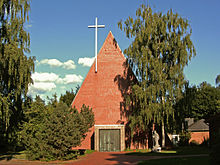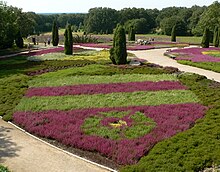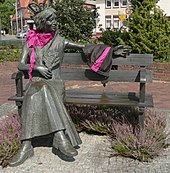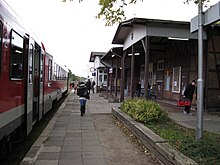Schneverdingen
| coat of arms | Germany map | |
|---|---|---|

|
Coordinates: 53 ° 7 ' N , 9 ° 48' E |
|
| Basic data | ||
| State : | Lower Saxony | |
| County : | Heidekreis | |
| Height : | 97 m above sea level NHN | |
| Area : | 234.61 km 2 | |
| Residents: | 18,750 (Dec. 31, 2019) | |
| Population density : | 80 inhabitants per km 2 | |
| Postal code : | 29640 | |
| Primaries : | 05193, 05198, 05199, 04265 | |
| License plate : | HK | |
| Community key : | 03 3 58 019 | |
| LOCODE : | DE SVN | |
| City structure: | 10 districts | |
City administration address : |
Schulstrasse 3 29640 Schneverdingen |
|
| Website : | ||
| Mayoress : | Meike Moog-Steffens ( independent ) | |
| Location of the town of Schneverdingen in the Heidekreis district | ||
Schneverdingen ( Low German / Plattdüütsch Snevern ) is a town in the Heidekreis district in Lower Saxony and belongs to the Hamburg metropolitan region . Schneverdingen is a starting point for tourism to the Lüneburg Heath Nature Park .
geography
Schneverdingen is located in the middle of the Lüneburg Heath between Soltau in the south, Rotenburg (Wümme) in the west and Buchholz in the north heath . The Lüneburg Heath Nature Park begins east of Schneverdingen .
In addition to Schneverdingen itself, the following localities belong to the municipality: Ehrhorn , Großenwede , Heber , Insel , Langeloh , Lünzen , Schülern , Wesseloh , Wintermoor and Zahrensen .
In addition, the Gallhorn, Meyerhof, (today located in the urban area: Hansahlen, Höpen) belong to the city.
Neighboring cities
|
Sittensen 32 km |
Buxtehude 45 km |
Buchholz (Nordheide) , Hamburg 29 km, 66 km |
|
Rotenburg (Wümme) , Bremen 28 km, 60 km |

|
Bispingen , Lüneburg 17 km, 60 km |
|
Neuenkirchen , Visselhövede , Verden 12 km, 22 km, 47 km |
Soltau 17 km |
Celle 65 km |
history
Schneverdingen was first mentioned in a document in 1231 . The Bishop Iso von Verden forced the Ministerial Lippold von Zahrenhusen to renounce the Bailiwick "Snewordinge".
Economic basis and development
The area around Schneverdingen is largely shaped by Ice Age influences and livestock farming, especially the Heidschnucken . Through the management of these cattle, in connection with the barren sandy soils, a large heathland was created ( overgrown with Calluna vulgaris ), which nowadays attracts many tourists. Nevertheless, neither livestock nor arable farming were productive, which is why there was never a high population density.

With the advent of mineral fertilizers , agriculture became more important, as large areas, previously moderately fertile, suddenly increasingly productive, were available. In the middle of the 19th century, other manual professions came to the fore. Great importance was the leather processing for the production of shoes . At its heyday, over 300 shoemakers worked in Schneverdingen . From this, numerous shoe factories developed, of which, however, only one company still exists today due to the structural change in this branch .
Development of transport, education and the military
The Heidebahn has been connecting Schneverdingen with Hamburg in the north and Hanover in the south since the beginning of the 20th century . She made an inglorious contribution to the history of the German Empire. People were transported to concentration camps on it , especially to the Bergen-Belsen concentration camp . Local historical research is still being carried out on this subject, which is why a final documentation is difficult to achieve.
At the beginning of the 20th century, the yacht designer Max Oertz maintained an airfield in Schneverdingen for test flights. The streets “Am Alten Flugplatz” and “Max-Oertz-Str.” Still bear witness to this today, the airfield has given way to residential areas. The streets mentioned are both on the former 500 acre site. Today's glider airfield in Reinsehlen was created later. In 1897 the local elementary school was built. Today the building is called "Old School". In 1942 the elementary school was converted into a secondary school.
At Easter 1912 the higher private school in Schneverdingen opened and was supposed to prepare boys for the one-year-old volunteer exam. Girls should receive appropriate instruction. At Easter 1920, the private school was merged into the newly established upscale section of the elementary school.
On April 1, 1940, the middle school opened, which arose from the upper section of the elementary school. Its first director was Rector Borschel, who also directed the elementary school.
From April 12, 1945 to December 14, 1945 the middle school had to close due to the war. The head of Meyer retired in the same year. His successor Meyer began teaching again. Much of the school facilities were destroyed by war and occupation. On January 7, 1947, the school moved into the rural year home in the Hansahlen district.
In 1965 a new school building was inaugurated for the now called Realschule am Timmerrahde. It was built by the Schweitzer architects from Braunschweig and cost 1,549,450.08 DM.
In Reinsehlen , part of the Insel district , a German air force airfield was built from 1938 onwards . During the Second World War it served as a training and operational airfield under the cover name Posemuckel . In the end of the war from 1945, the first new types of jet aircraft were stationed at the airfield , such as the first jet-powered bomber Arado 234 . After the invasion of British troops, they used the military facilities and accommodation, but made them available to German authorities in 1946 to accommodate refugees and displaced persons . From 1946 on, an average of about 1500 people lived there, making it one of the largest refugee camps in northern Germany . In 1949 the British occupation forces demanded the camp to be set up for a military training camp. From 1950 the former airfield was used as a base camp for British tank exercises in the Lüneburg Heath under the name of Camp Reinsehlen .
Development of the city
After the Second World War the place changed. The population grew rapidly. On March 1, 1974, the communities of Großenwede, Heber, Insel, Langeloh, Lünzen, Schülern, Wesseloh, Wintermoor and Zahrensen as well as larger areas of the dissolved community of Ehrhorn, which had a population of slightly more than 600 at that time, were incorporated. On October 30, 1976, Schneverdingen received city rights.
Schneverdingen is in the area where the Low German language is distributed . Efforts are being made to introduce children to the language at an early age, which in previous decades has increasingly been pushed out of public life. Between 2006 and 2009, the place-name signs in most places in the municipality of Schneverdingen were gradually replaced with bilingual place-name signs.
religion
The majority of denominational residents belong to the Evangelical Lutheran regional church . There are a total of three Evangelical Lutheran congregations: the Peter and Paul Church , the Markus congregation with the One World Church and the Heber Church of Peace.
The Roman Catholic branch community of St. Ansgar has been part of the Soltau parish of St. Maria since 2006 . Your church, located on Feldstrasse, was built in 1962/63, the outer shape of which was modeled on a heather sheep barn.
There are also three free-church congregations in Schneverdingen: The Christ Church on Freudenthaler Strasse belongs to the Bund Freikirchlicher Pentecostal congregations . The Free Evangelical Congregation, whose beginnings go back to 1902, built its club house on Grünhagenstrasse in 1904/05. In 1984 a larger parish hall on Heinrich-Loose-Straße, the building of a former vocational school, was inaugurated. In 2003 the Johannes-Congregation (free-church Protestant house church) was founded.
There is also a New Apostolic congregation in the Lüneburg district with its church on Schröderstrasse as well as Jehovah's Witnesses and members of Islam .
In the district of Lünzen there is a Buddhist meditation house of the Tibetan Center Hamburg, in which some nuns and monks of the Tibetan Gelugpa tradition live, which also conducts public seminars.
politics
Schneverdingen is divided into the core town of Schneverdingen and ten localities. Each of the localities has a mayor . These are determined by the city council on the proposal of the parliamentary group whose members belong to the party or electoral group that received the most votes in the respective town in the last city council election.
Mayoress
The full-time mayor has been Meike Moog-Steffens since November 1, 2011 (non-party, but running for the SPD). Honorary deputy mayors have been Hans-Jürgen Thömen ( SPD ), Karin Meyer (CDU) and Carsten Gevers ( Bündnis 90 / Die Grünen ) since 2016 .
City Council
The city council consists of the full-time mayor and 32 other councilors. According to the results of the 2011 local elections, the SPD had a total of 14, the CDU 11, Bündnis 90 / Die Grünen 5, and a local electoral community and the NPD each had one seat. The parliamentary groups of the SPD and Bündnis 90 / Die Grünen formed one Group with which she had an absolute majority (19 of the 32 honorary council members).
The 2016 local elections resulted in the following composition of the council:
- 17 seats - group SPD (13) / GREEN (4)
- 10 seats - CDU parliamentary group
- 3 seats - SFA group (SWG, FDP, Liberal-Conservative Reformers (LKR), 1 each)
- 2 seats - AfD (of which one seat in the council remains vacant until the end of the electoral period in accordance with Section 36 (7) Lower Saxony Local Election Act (NKWG))
In the administrative committee, which is the second highest decision-making body in the city after the city council and before the mayor, the SPD sends four members, the CDU three and Bündnis 90 / Die Grünen an alderman. The First City Councilor Mark Söhnholz (independent) has a seat with an advisory vote.
coat of arms
| Blazon : “Divided by silver (white) and red; above a red bar, below a silver (white) rose with a golden (yellow) calyx. " | |
| Justification of the coat of arms: The coat of arms awarded by the President of the Prussian Province of Hanover in 1937 is derived from the family coat of arms of the local lords of Schneverding, who died out in the 17th century. |
flag
 |
Hoisted flag: "The flag has red and white stripes with the coat of arms in the middle." |
Town twinning
Schneverdingen has had an active partnership with the Polish town of Barlinek (formerly Berlinchen ) in the West Pomeranian Voivodeship (formerly Soldin district) since 1993. In order to fill the partnership with life, the German-Polish Society Schneverdingen e. V. founded. In return, a Polish-German society was founded on the Polish side. Numerous encounters have taken place since then. Initially it was mutual visits by the “officials”, but the partnership was increasingly enriched by contacts at the club and school level.
At its meeting on June 7, 2001, the city council of Schneverdingen decided on a further twinning with Eksjö in Sweden . Since a partnership between Eksjö and Barlinek has existed since 1996, the three-way relationship between Schneverdingen-Barlinek-Eksjö was complete. The partnership certificate was in Eksjö during the event "Eksjö-Tattoo" from 2nd to 5th August 2001 and in Schneverdingen during the city anniversary on 27./28. Signed October 2001. The partnership with Eksjö ended at the end of 2018.
Culture and sights
Buildings
- Peter and Paul Church from 1745/1746 - Your parish was first mentioned in a document in 1231. There is no evidence of the predecessor churches.
- The One World Church was built in 1999 as part of a decentralized Expo 2000 project using wood. Within the One World Church, numerous soil and sand samples are collected in so-called books, which come from donors from all over the world.
- Schneverdingen glider airfield ( Reinsehlen )
- City fountain by the sculptor Frijo Müller-Belecke
- Local history museum “de Theeshof” as a rural homestead with a bakery, barn, stable, staircase and the registry office's wedding room
- The Reinsehlen camp with an art course is an almost tree-free area, which is known for its large sandy lawn .
One World Church in Schneverdingen
The Pietzmoor is located in the nature reserve of the Südheide
Heath in the roundabout in the heather garden
Architectural monuments
Monuments
- Memorial at the train station in memory of 62 concentration camp prisoners who were buried in a pit at Schneverdingen train station in April 1945 by Wehrmacht soldiers. The monument design was created in 2019 as part of an art competition organized by the Integrated Comprehensive School in Schneverdingen.
Green spaces and recreation
- Lueneburg Heath
- "Höhenwegarena" climbing fun park
- The Pietzmoor is the largest contiguous moor in the Lüneburg Heath
- Heidegarten “im Höpen” in the Lüneburg Heath Nature Park
- Heidjers Wohl, adventure pool and sauna
Sports
The TV Jahn Schneverdingen is the largest association in the district with almost 3500 members. In women's fistball, TV Jahn is one of the most successful clubs with numerous German championships and successes in the European Cup and World Cup .
The handball development association Schneverdingen organized annually the International Heide-Cup , an occupied with German and international top clubs handball tournament from the Schneverdinger KGS Hall.
Regular events
Local traditions, such as the Easter bonfires , the planting of the Pentecost trees and the Whitsun chariot (mainly in the villages around Schneverdingen), are maintained in Schneverdingen.
- Since 1922 a heather queen has been elected every year in Schneverdingen . This is connected with the heather blossom festival , which is a crowd puller . The highlight is the parade and the festival followed by the coronation of the new heather queen on the last Sunday in August on the open-air stage in Höpental.
- Höpen Air , music festival
Economy and Infrastructure
Companies
Today, more than 1,500 sites from the fields of industry , craft , trade and services shape the cityscape and provide around 4,000 jobs.
Due to the special scenic location, tourism has become the most important economic factor with around 200,000 annual overnight stays , especially after the military use of the Soltau-Lüneburg training area around the British military camp Camp Reinsehlen was given up in 1994 .
Thanks to intensive club work, it was possible to set up a cinema and bring a citizens' bus to life.
Heidekeks GmbH (since 2019, previously Bisquiva GmbH & Co. KG 2009–2019, previously Gottena ) has its production site in Schneverdingen . The company has been part of the Hans Freitag Group ( Verden ) since November 1st, 2019 . The company previously belonged to the Bahlsen Group (1995–2019), after having belonged to the Brandt company from 1988 to 1995 .
Public facilities
The Schneverdingen volunteer fire brigade, founded in 1895, has around 480 active comrades in their local fire brigades, providing fire protection and general help. City fire chief has been Manfred Ehlermann since 2012 and his two deputies are Christian Schmalenberg and Gerd Bürger.
education
There are ten day-care centers in Schneverdingen for the elementary sector.
The primary sector is covered by four primary schools, which are run by the city of Schneverdingen. The elementary school in Hansahlen was founded in 1995 and has been run by Wilfried Diekmann since 2005. Today around 250 children attend the three-class school, where 28 people work. There has been a cooperation agreement with the Am Jordan kindergarten, the Insel and Wesseloh play groups since 2007. In the 2011/2012 school year, the first and second grade levels were merged into a common entrance level. The Lünzen elementary school also set up an entrance level in the same school year. She has concluded cooperation agreements with the Lünzen daycare center and the school children play group. Nine people and around 80 students work on it under the direction of Mirja Meyer. The primary school is an open all-day school. At the primary school on Pietzmoor founded in 1972, 19 people work with the director Christine von Fintel. The 180 children are divided into eight classes. Since the 2011/2012 school year it has also been an open all-day school. The primary school in the Osterwald, headed by Jürgen Becours, has also been an open all-day school since 2011/2012. Around 270 students in twelve classes are taught by 16 teachers and seven pedagogical staff.
The Osterwaldschule Schneverdingen has been a special needs school with a focus on learning since 2004 and is headed by Klaus Hülsmann. In 1956 an auxiliary school class or special school class was set up in the elementary school. In 1959 the class was spun off and continued as a special school or auxiliary school . In 1965 she moved to the building of the former secondary school. Since 1973 it has been housed in the building on the Osterwald. In 1982, the type of school was renamed as a special school for the learning disabled and in 2001 as a school for learning assistance . Today 51 students are taught in it by nine teachers from the first to the ninth grade.
The only school in Schneverdingen for secondary education is, besides the Osterwaldschule, the Cooperative Comprehensive School Schneverdingen (KGS Schneverdingen), which is sponsored by the Heidekreis district and which comprises three branches of secondary school, secondary school and grammar school with an upper level leading to the Abitur.
In 1955 the community library was founded in the archive rooms of the town hall and in 1983 moved to the "old school". In 2011 she was awarded the title “Library with Quality and Seal”. Today the library is managed by Veronika Veit and has a stock of 23,000 media.
The Alfred Toepfer Academy for Nature Conservation (NNA) is the education and training facility of the State of Lower Saxony for nature conservation and landscape management.
traffic
Schneverdingen is traditionally oriented towards Hamburg. Many working people commute to Hamburg every day, Schneverdingen is sometimes referred to as the southernmost tip of the “ Hamburg bacon belt ”. This affiliation is also supported by the fact that Schneverdingen has meanwhile been connected to the HVV ( Hamburg Transport Association ). Schneverdingen has an exit on the federal highway 7 , which is located on the federal highway 3 . In addition, Schneverdingen has a train station on the Heidebahn .
Personalities
Sons and daughters of Schneverdingen
- Fritz-Christoph Duden (1939–2017), civil servant and member of the Hamburg Parliament
- Peter Goerke-Mallet (* 1955), mining engineer and mine surveyor at the Ibbenbüren mine
- Uwe Harten (* 1944 in the Ehrhorn district), German musicologist
- Ewald Hillermann (1906–2003), author of Low German stories, poems and lyrics
- Karsten Möring (* 1949), German politician
- Cimo Röcker (* 1994), German soccer player
Personalities who have worked on site
- Johann Christian Meier (1732–1815), educator, pastor and writer; died here
- Max Oertz (1871–1929), yacht designer; maintained an airfield in Schneverdingen
- Gustav Bosselmann (1915–1991), CDU politician, former Minister of Justice and Interior of Lower Saxony, died here
- Uwe Friedrichsen (1934-2016), German actor, audio book and voice actor
- Jörg-Werner Schmidt (1941–2010), painter and installation artist with a studio in Camp Reinsehlen
- Matthias Schloo (* 1977), German actor, grew up in Schneverdingen
literature
- Gerhard Röper: 750 years of Schneverdingen . With a contribution by Wilhelm Thömen. City of Schneverdingen, Schneverdingen 1981.
- Walter Peters: 40 years of Schneverdingen. 1946-1986. Facts data pictures. A documentation. City of Schneverdingen, Schneverdingen 1987.
- Dierk Lawrenz, Lothar Eichmann: The Heidebahn. From Buchholz via Schneverdingen to Soltau. 85 years through the Lüneburg Heath. EK-Verlag, Freiburg 1986, ISBN 3-88255-209-3 . (2nd, revised and newly illustrated edition. EK-Verlag, Freiburg 1997, ISBN 3-88255-419-3 )
- Evangelical Lutheran Church of Peter and Paul in Schneverdingen (ed.): 250 years of Peter and Paul Schneverdingen 1746 to 1996. Festschrift for September 15, 1996 on the occasion of the 250th anniversary of the Peter and Paul Church in Schneverdingen. Schneverdingen 1996.
- Olaf Grohmann (author); Stadtwerke Schneverdingen (Ed.): 100 years of electricity for Schneverdingen. From community power station to modern service company. Verlag ecrivir, Hannover 2006, ISBN 3-938769-04-1 .
Web links
- Official website of the municipality with tourist information
- The bilingualism of place names
- History of the Heidebahn in Wintermoor and Schneverdingen, eyewitness reports
Individual evidence
- ↑ State Office for Statistics Lower Saxony, LSN-Online regional database, Table 12411: Update of the population, as of December 31, 2019 ( help ).
- ↑ alte-mittelschule-schneverdingen.de
- ↑ a b Federal Statistical Office (ed.): Historical municipality register for the Federal Republic of Germany. Name, border and key number changes in municipalities, counties and administrative districts from May 27, 1970 to December 31, 1982 . W. Kohlhammer, Stuttgart / Mainz 1983, ISBN 3-17-003263-1 , p. 235 and 236 .
- ↑ Schneverdingen - City Council 2016, final result , accessed on November 2, 2017.
- ↑ schneverdingen.de
- ↑ Klemens Stadler: German coat of arms. Volume 5, Bremen 1970, p. 71.
- ↑ The Schneverdinger city arms
- ^ Flag of the city of Schneverdingen
- ↑ Entry about the twin cities on the homepage of the city of Schneverdingen.Retrieved on April 24, 2019.
- ↑ Peter and Paul Church Schneverdingen
- ↑ Memorial: Schneverdingen commemorates concentration camp prisoners. at ndr.de on March 31, 2019.
- ↑ Carolin George: How a place successfully defies rural exodus. welt.de, July 14, 2014, accessed on July 15, 2014.
- ↑ day care centers
- ^ Cathrin Mahns: New start in Lünzen . In: Böhme newspaper. August 18, 2010.
- ↑ schneverdingen.de





















